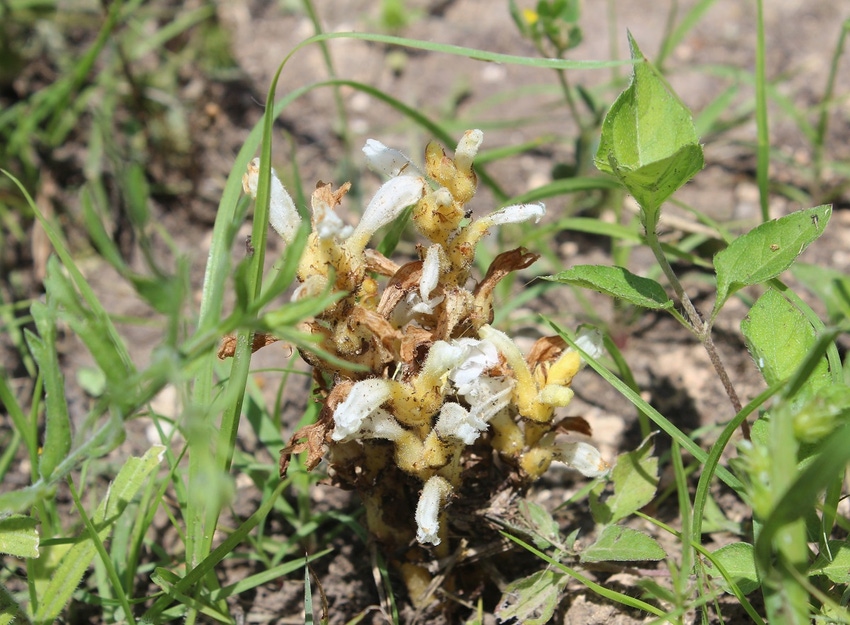
A noxious, invasive, parasitic weed first identified in Karnes County, Texas, in 1981 is back in the area, and if not controlled, threatens vegetable production in the Winter Garden and Rio Grande Valley areas.
Branched broomrape has been reported this year at six sites in Karnes County, but observers expect additional infestations.
A recent fact sheet from Texas A&M AgriLife Research and Extension notes that plants have been identified in cemetery sites, pasturelands, and roadside rights-of-way in Karnes County and surrounding areas.
“It severely threatens the vegetable industry in the Winter Garden region and Rio Grande Valley due to high potential for spread through equipment,” says the AgriLife notice. The plant attacks a wide range of crops, including tomato, bell pepper, potato, eggplant, cabbage, coleus, onion, broad bean, celery, carrot, and sunflower.
“Broomrape lacks chlorophyll and is unable to produce food through photosynthesis. This plant robs all nourishment from its host plant by attaching to the host roots through a structure called haustoria.”
Task force formed
Texas AgriLife has formed a task force to coordinate efforts to identify, monitor and control broomrape in Karnes County and surrounding areas to prevent spread to Winter Garden and into the Valley. The group is asking help from farmers and others in locating additional infestations.
“Best place to check are fence lines close to state and county highways,” the fact sheet notes. Other likely infestation sites include where mowers, tractors, and other implements are stored.
Farmers who suspect broomrape infestations should notify local county Extension offices (Jared Alewine in Karnes county, [email protected], phone (830) 780-3906. The task force chair is Muthu Bagavathiannan, who can be reached at (979) 845-5375 or [email protected]
Bagavathiannan cautions farmers not to pull plants if they have already turned brown. “You may unintentionally spread seed.”
Effective control includes integration of physical, chemical, mechanical, and possibly cultural practices. Small, confined infestations may be controlled by physically pulling emerged plants prior to seed maturity. Spraying the host plant with glyphosate is an effective chemical strategy. As a systemic herbicide, glyphosate translocates to the plant’s root system and destroys the parasite attached to it. Mechanical control includes tillage, flame throwing, and other options. Planting flax is another possibility; it acts as a false host and the broomrape can be destroyed as it emerges from the ground.
Extension sources say broomrape emerges in multiple flushes, making periodic treatments necessary to prevent seed production from each flush.
Lengthy seed persistence
The tiny seed, about the size of a dust particle, persist in the soil for years, possibly more than 10, and not all seeds in the soil emerge the same year. One broomrape plant can produce more than 50,000 seeds, which then can be spread by farm equipment, water, wind, and animals.
Because of the combination of small seed, persistence in the soil, multiple flushes, and the large number of seeds produced per plant, effective control and quarantine require sustained, long-term efforts. Persistence is apparent, as evidenced by the recent identification of the weed after several years with no sightings.
Following discovery of broomrape in Karnes County in 1981 (along with documented identification in nearby Goliad, Bee, DeWitt, and Atascosa counties) the U.S. Department of Agriculture, the Texas Department of Agriculture, and Texas A&M AgriLife Extension monitored and sprayed infested sites to keep the weed in check.
“Those efforts were discontinued in 2008, as government funding for the program was no longer available due to budget cuts,” notes the AgriLife report.
Broomrape seed germinate from December through February in South Texas. Plants begin to emerge in February, but most don’t emerge until March and April. Multiple flushes, called cohorts, occur in a single season. First flower may appear within three days after emergence and mature seeds may be produced 14 days after flowering.
About the Author(s)
You May Also Like






